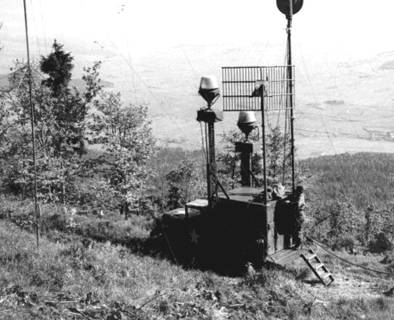Project 415, also referred to as ECHELON, was a worldwide surveillance initiative that purportedly operated during the Cold War period by the United States, the United Kingdom, Canada, Australia, and New Zealand. The program was allegedly intended to intercept and monitor electronic communications, such as phone calls, emails, and other forms of digital communication. Its existence first surfaced in the 1990s and prompted a storm of controversy and criticism from some privacy advocates, who voiced apprehension about the prospect of government overreach and infringement of personal privacy rights.
The fact that national intelligence agencies operate extensive surveillance systems is an accepted fact of life for most people. Increasingly, true privacy seems like a thing of the past. However, this hasn’t always been the case. Throughout the Cold War, a massive yet secret war was taking place. Instead of using planes, tanks, and rifles, nations used the information to fight this war. One of the most important and influential components of this was Signals Intelligence (SIGINT).
SIGINT, according to the National Security Agency (NSA), refers to “electronic signals and systems used by foreign targets, such as communications systems, radars, and weapons systems” (source). Because of its highly technical nature, SIGINT generation for great powers is the purview of specialised intelligence agencies. These include the American NSA and the British General Communications Headquarters (GCHQ). Throughout the latter half of the Cold War, the anglosphere, united by similar goals, created an extensive surveillance system. Finally, in 2013, the Edward Snowden leaks confirmed its existence (source).
This article examines the Project 415 surveillance system during the Cold War. In doing so, it will detail its origin, components, and the decades-long quest to uncover it.
1.0: Building A Surveillance System Network
This story, like many, begins with World War II (WWII). In 1941, the United States (US) and the United Kingdom (UK) began sharing intelligence pertinent to their interests (source). Notably, this was before the US entrance into WWII (source). The Sinkov Mission, named for the leader of the American party Abraham Sinkov, journeyed to Bletchley Park to share the codes to break Japanese cyphers (source). In response, the British revealed the existence of the Bombe machine, capable of breaking the Enigma code (source). Before long, cooperation takes place with regularity (source). On 17 May 1943, both nations signed the BRUSA Agreement, which stipulates intelligence sharing in support of the European war effort (source). The formalisation of cooperation sets the groundwork for intelligence sharing between the countries that characterise the Cold War and the modern era (source).

1.1: The UKUSA Alliance
In 1948, with the threat of the East looming, the US and UK signed the UKUSA Agreement (source). Later members include Australia, Canada, and New Zealand (source). This unity of the anglosphere is still present today in what is commonly known as Five Eyes. The primary target of this coalition were Eastern Bloc countries; the United Soviet Socialist States (USSR), its satellites, and the Peoples’ Republic of China (PRC) (source). However, UKUSA also spied on nominally neutral countries and allies (source). Targets included Israel, France, Angola, Ecuador, India, Egypt, Indonesia, Lybia, and many more (source).


UKUSA is the means by which Project 415 functions. SIGINT communication interception may be location dependent, depending on the strength of the signal in question (source). Additionally, some avenues of surveillance, such as underwater communication cables, can only be accessed physically (source). Equally important is the access to additional personnel to analyse the information collected (source). The UKUSA agreement benefited all parties; the US acted as the investor, while the UK and the commonwealth members provided analysis and collection locations (source).
1.2: Parties to UKUSA
Essential to understanding UKUSA is the notion of a tiered membership system. There are three classifications; first, second, and third party (source). First party refers to the country of origin of a writer/speaker (source). Thus, an American speaker would refer to its intelligence community and the material it has collected/analysed as the first party. In contrast, the other signatories would be second parties (source). The same applies to Australians, British, Canadians, or New Zealanders in the same position (source). Third-party refers to material obtained from outside the alliance (source). Despite the nature of UKUSA as a creation of the anglosphere, non-English-speaking countries can sign agreements to exchange SIGINT for analysis (source). As of 2001, ten countries have made formal third-party agreements with the US (source). These include;
- Austria
- Denmark
- Germany
- Greece
- Italy
- Japan
- Norway
- South Korea
- Thailand
- Turkey
Additionally, during the Cold War, countries made ad hoc arrangements with UKUSA for similar ends (source). These include;
- Belgium
- Finland
- France
- Luxembourg
- Portugal
- Spain
- Sweden
2.0: Components of Project 415
Project 415 refers to a wide variety of surveillance systems (source). These include ground-based and undersea cable traffic interceptions, high-frequency radio interceptions, space-based interceptions, and covert means (source).
Note: Project 415 and ECHELON are often conflated (source). In reality, ECHELON is just one component of Project 415 (source).
2.1: Cable Interception
Even before the creation of the UKUSA alliance, the NSA had already established a process of intercepting cable traffic (source). Codenamed Operation SHAMROCK, this programme had the support of major commercial cable companies (source). The NSA, and later, GCHQ, used this trove of information to spy on friends and foes (source).

In contrast to above-ground cables, undersea cable interception was assumed to be immune from surveillance (source). However, in 1971, the USS Halibut successfully tapped USSR cables deep below the Pacific, running to the Kamchatka Peninsula (source). Using tap pods, codenamed IVY BELLS (presumably named after the Halibut’s 1971 operation), American subs routinely intercepted supposedly secure undersea communications throughout the later Cold War, often disguised as deep-sea rescue vehicles (source). Targets included both Soviet and non-Soviet cables (source).
2.2: High-Frequency Radio Interception
Also occurring at the same time was High-frequency radio interception (source). NSA and GCHQ operated thousands of individual collection stations (source). These ranged from isolated cabins housing two or three analysts to massive bases such as MOD Chicksands (source). Sites locations include Hong Kong, Iran, Germany, Spain, and Guam (source). Location is a critical component of this method of surveillance, hence the various locations listed above (source).

This is part of why the UKUSA agreement was so valuable during the Cold War. British colonial holdings and agreements with former colonies enabled collection from a wide geographical range. For instance, Ayios Nikolaos, located in Cyprus, could intercept signals emanating from Soviet-held central Asia, the Mediterranean basin, and large portions of Africa (source).
2.3: Space-based Interception
Since the introduction of satellites for communication purposes, UKUSA has extensively relied on space-based intelligence gathering (source). These include interceptions of communications on the ground using satellites and intercepting communications from satellites (source).
The CANYON programme first launched in August 1968 (source). By 1977, the US had launched a further six (source). Most of these orbited above Siberia, which, due to permafrost, underground cables were unusable (source). Due to the immense distance of its interior, the USSR utilised dozens of intermediate stations to bounce communications to and from communication hubs (source). This process leaks a significant amount of signal data into the atmosphere (source). Thus, CANYON gathered immense communications intelligence (COMINT) from the USSR (source). CHALET (later called VORTEX and MERCURY) followed CANYON in 1978 (source). Ground stations in Europe, ranging from Menwith Hill, England, to Bad Aibling, Germany, controlled these satellites (source).

In contrast to the COMINT satellites described above, SIGINT satellites collect a more comprehensive range of atmospheric signal data (source). The first of this class of satellites, RHYOLITE (later AQUACADE) launched in 1985 (source). The US was the only nation able to manufacture these satellites during the Cold War (source). Pine Gap, Australia, served as a hub for these satellites (source).
2.3.1: The ECHELON Surveillance System
Since 1971, UKUSA has put extensive effort into intercepting satellite communications from the ground (source). This program is codenamed ECHELON (source). By 2000, the UKUSA alliance operated 120 antennae devoted to satellite interception located across seven sites (source). Of these, 40 monitored western communications satellites, 30 controlled SIGINT satellites such as RHYOLITE, and 50 were formerly tasked with Soviet communications satellites. However, this latter category was defunct at the time of the report, and these antennae have certainly been retasked (source). These ECHELON stations largely operate remotely, uploading data to the global network used by UKUSA (source). Once uploaded, a “Dictionary” system filters items of interest to customers based on requests from that customer (source). Once received, customers can begin the analysis of data (source).
2.4: Covert Means
Sometimes, it is impossible to access signals in the ways described above. If this occurs, physical installation of surveillance equipment in embassies or diplomatic premises is required (source). Alternatively, personnel may carry surveillance equipment to a point of interest (source). For these purposes, the joint NSA/CIA Special Collection Service creates specialised equipment, such as the ORATORY system (source). ORATORY functions similarly to the Dictionary system of ECHELON (source). However, it comes in a small, suitcase-sized package for easy transportation (source).

3.0: Discovery
Though long reputed to exist, Project 415 was never officially acknowledged by any party of the UKUSA Alliance.
The first indication of Project 415’s existence comes from a press conference held by two NSA defectors. In 1960, William H. Martin and Bernon F. Mitchell stated;
“We know from working at NSA (that) the United States reads the secret communications of more than forty nations, including its own allies (…) NSA keeps in operation more than 2000 manual intercept positions (…) Both enciphered and plain text communications are monitored from almost every nation in the world, including the nations on whose soil the intercept bases are located” (source).
The second came in the wake of the Watergate trial. In 1975, the NSA admitted to “incidental” surveillance on American citizens (source).
3.1: Building a Stronger Case
Enter Duncan Campbell, the Scottish investigative journalist who created the scandalous BBC series Secret Society, which exposed British attempts to launch a SIGINT satellite of its own (source). Secret Society was so damning that the British Government interfered in its broadcasting schedule and authorised a raid on Campbell’s home (source). In 1988, Campbell published an article, “They’ve got it taped”, in which he detailed Project 415 and the global nature of its surveillance systems (source). In 2000 and 2001, Campbell drafted formal reports for the European Parlament on Project 415’s capabilities and components (source). However, very little came from this. The EU report “reflected not only that NSA played by the rules, with congressional oversight, but that those characteristics were lacking when the Commission applied its investigatory criteria to other European nations” (source).

3.2: Final Confirmation
In 2002, Bruce McIndoe, a former NSA employee from 1987 – 1998, all but confirmed that ECHELON, and therefore Project 415, existed. Speaking to Danish reporters, he stated;
“No system of such enormous magnitude would only be used for a single purpose. They (the Department of Defence) use it for everything they can, if they feel it’s necessary. Whenever they need to exploit its potential, they do it” (source).
The 2013 Snowden leaks affirmed the worldwide nature of UKUSA surveillance, as detailed previously (source). A document from this release, found by The Intercept in 2015, confirmed the existence of ECHELON and its purpose in “targeting communications satellites” (source).
Therefore, the prior insinuations hold water. UKUSA created a massive surveillance system capable of spying on vast swathes of the population, including nominal allies. What is truly remarkable about Project 415 is how long it remained a secret. From the first implicit mention of it in 1960, it remained secret for 28 years before the Campbell article. It took another 25 years after that for concrete confirmation.

